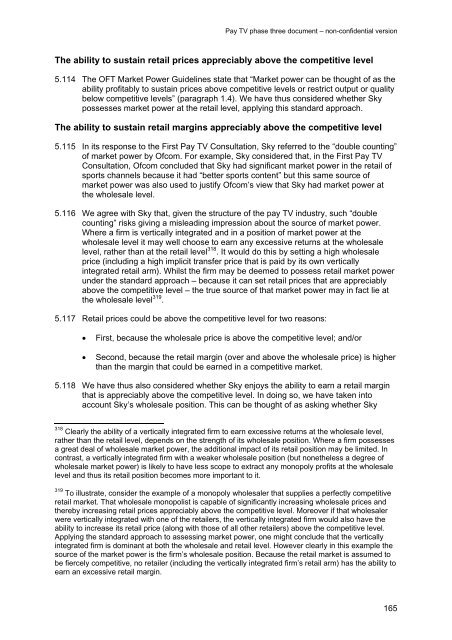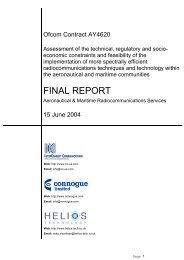Pay TV phase three document - Stakeholders - Ofcom
Pay TV phase three document - Stakeholders - Ofcom
Pay TV phase three document - Stakeholders - Ofcom
You also want an ePaper? Increase the reach of your titles
YUMPU automatically turns print PDFs into web optimized ePapers that Google loves.
<strong>Pay</strong> <strong>TV</strong> <strong>phase</strong> <strong>three</strong> <strong>document</strong> – non-confidential version<br />
The ability to sustain retail prices appreciably above the competitive level<br />
5.114 The OFT Market Power Guidelines state that “Market power can be thought of as the<br />
ability profitably to sustain prices above competitive levels or restrict output or quality<br />
below competitive levels” (paragraph 1.4). We have thus considered whether Sky<br />
possesses market power at the retail level, applying this standard approach.<br />
The ability to sustain retail margins appreciably above the competitive level<br />
5.115 In its response to the First <strong>Pay</strong> <strong>TV</strong> Consultation, Sky referred to the “double counting”<br />
of market power by <strong>Ofcom</strong>. For example, Sky considered that, in the First <strong>Pay</strong> <strong>TV</strong><br />
Consultation, <strong>Ofcom</strong> concluded that Sky had significant market power in the retail of<br />
sports channels because it had “better sports content” but this same source of<br />
market power was also used to justify <strong>Ofcom</strong>’s view that Sky had market power at<br />
the wholesale level.<br />
5.116 We agree with Sky that, given the structure of the pay <strong>TV</strong> industry, such “double<br />
counting” risks giving a misleading impression about the source of market power.<br />
Where a firm is vertically integrated and in a position of market power at the<br />
wholesale level it may well choose to earn any excessive returns at the wholesale<br />
level, rather than at the retail level 318 . It would do this by setting a high wholesale<br />
price (including a high implicit transfer price that is paid by its own vertically<br />
integrated retail arm). Whilst the firm may be deemed to possess retail market power<br />
under the standard approach – because it can set retail prices that are appreciably<br />
above the competitive level – the true source of that market power may in fact lie at<br />
the wholesale level 319 .<br />
5.117 Retail prices could be above the competitive level for two reasons:<br />
� First, because the wholesale price is above the competitive level; and/or<br />
� Second, because the retail margin (over and above the wholesale price) is higher<br />
than the margin that could be earned in a competitive market.<br />
5.118 We have thus also considered whether Sky enjoys the ability to earn a retail margin<br />
that is appreciably above the competitive level. In doing so, we have taken into<br />
account Sky’s wholesale position. This can be thought of as asking whether Sky<br />
318 Clearly the ability of a vertically integrated firm to earn excessive returns at the wholesale level,<br />
rather than the retail level, depends on the strength of its wholesale position. Where a firm possesses<br />
a great deal of wholesale market power, the additional impact of its retail position may be limited. In<br />
contrast, a vertically integrated firm with a weaker wholesale position (but nonetheless a degree of<br />
wholesale market power) is likely to have less scope to extract any monopoly profits at the wholesale<br />
level and thus its retail position becomes more important to it.<br />
319 To illustrate, consider the example of a monopoly wholesaler that supplies a perfectly competitive<br />
retail market. That wholesale monopolist is capable of significantly increasing wholesale prices and<br />
thereby increasing retail prices appreciably above the competitive level. Moreover if that wholesaler<br />
were vertically integrated with one of the retailers, the vertically integrated firm would also have the<br />
ability to increase its retail price (along with those of all other retailers) above the competitive level.<br />
Applying the standard approach to assessing market power, one might conclude that the vertically<br />
integrated firm is dominant at both the wholesale and retail level. However clearly in this example the<br />
source of the market power is the firm’s wholesale position. Because the retail market is assumed to<br />
be fiercely competitive, no retailer (including the vertically integrated firm’s retail arm) has the ability to<br />
earn an excessive retail margin.<br />
165
















